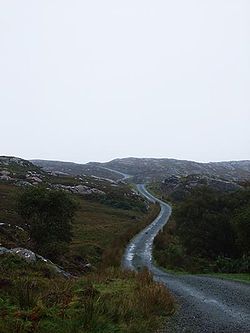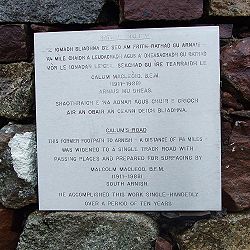
Calum MacLeod (of Raasay)
Encyclopedia


British Empire Medal
The Medal of the Order of the British Empire for Meritorious Service, usually known as the British Empire Medal , is a British medal awarded for meritorious civil or military service worthy of recognition by the Crown...
(15 November 1911 - 26 January 1988) was a crofter who famously built Calum's Road on the Island of Raasay
Raasay
Raasay is an island between the Isle of Skye and the mainland of Scotland. It is separated from Skye by the Sound of Raasay and from Applecross by the Inner Sound. It is most famous for being the birthplace of the poet Sorley MacLean, an important figure in the Scottish literary renaissance...
, Scotland
Scotland
Scotland is a country that is part of the United Kingdom. Occupying the northern third of the island of Great Britain, it shares a border with England to the south and is bounded by the North Sea to the east, the Atlantic Ocean to the north and west, and the North Channel and Irish Sea to the...
. He was Local Assistant Keeper of Rona
South Rona
Rona , sometimes called South Rona to distinguish it from North Rona, is a small island in the Scottish Inner Hebrides, north of Raasay and northeast of Skye. It has a total area of .-Geography and geology:...
Lighthouse and the part-time postman for the north end of Raasay.
Early life
Calum was the son of Donald MacLeod of Arnish (Raasay) and Julia Gilles of FladdaEilean Fladday
Eilean Fladday is a previously populated, tidal island off Raasay, near Skye.-Geography:Eilean Fladday lies off the north west coast of Raasay, across Caol Fladday , which dries at half-tide....
. He was born in Glasgow as his father was working in the merchant navy. With the outbreak of World War I
World War I
World War I , which was predominantly called the World War or the Great War from its occurrence until 1939, and the First World War or World War I thereafter, was a major war centred in Europe that began on 28 July 1914 and lasted until 11 November 1918...
, Calum and his mother moved to the croft
Croft (land)
A croft is a fenced or enclosed area of land, usually small and arable with a crofter's dwelling thereon. A crofter is one who has tenure and use of the land, typically as a tenant farmer.- Etymology :...
and house adjacent to that of his grandfather, in northern Raasay. Calum had 2 brothers, Ronald and Charles, and 3 sisters, Bella Dolly (died in the 1919 Spanish flu pandemic), Katie and Bella.
Calum attended Torran school, with its single teacher, James Mackinnon (Seumas Ruadh). He married Alexandrina (Lexie) Macdonald (1911 - 2001).
Road building
Calum and his brother, Charles, constructed the track from Torran to Fladda (Eilean FladdayEilean Fladday
Eilean Fladday is a previously populated, tidal island off Raasay, near Skye.-Geography:Eilean Fladday lies off the north west coast of Raasay, across Caol Fladday , which dries at half-tide....
), over three winters from 1949-1952. For this, they were each paid £35 a year by the local council.
After decades of unsuccessful campaigning by the inhabitants of the north end of Raasay for a road, and several failed grant applications, Calum decided to build the road himself. Purchasing Thomas Aitken's manual Road Making & Maintenance: A Practical Treatise for Engineers, Surveyors and Others (London, 1900), for half a crown
British Half Crown coin
The half crown was a denomination of British money worth half of a crown, equivalent to two and a half shillings , or one-eighth of a pound. The half crown was first issued in 1549, in the reign of Edward VI...
, he started work replacing the old narrow footpath. Over a period of about ten years (1964-1974), he constructed one and three quarter miles of road between Brochel Castle and Arnish using little more than a shovel
Shovel
A shovel is a tool for digging, lifting, and moving bulk materials, such as soil, coal, gravel, snow, sand, or ore. Shovels are extremely common tools that are used extensively in agriculture, construction, and gardening....
, a pick and a wheelbarrow
Wheelbarrow
A wheelbarrow is a small hand-propelled vehicle, usually with just one wheel, designed to be pushed and guided by a single person using two handles to the rear, or by a sail to push the ancient wheelbarrow by wind. The term "wheelbarrow" is made of two words: "wheel" and "barrow." "Barrow" is a...
. Initial blasting work was carried out and funded, to the sum of £1,900, by the Department of Agriculture's Engineering Department, who supplied a compressor, explosives, driller, blaster, and men.
Several years after its completion, the road was finally adopted and surfaced by the local council. By then Calum and his wife, Lexie, were the last inhabitants of Arnish.
Recognition
Calum was awarded the British Empire MedalBritish Empire Medal
The Medal of the Order of the British Empire for Meritorious Service, usually known as the British Empire Medal , is a British medal awarded for meritorious civil or military service worthy of recognition by the Crown...
"for maintaining supplies to the Rona light". The citation could not say for constructing a road which had been the subject of conflict with the authorities for twenty years.
Calum's Road has been commemorated in song by Capercaillie
Capercaillie (band)
Capercaillie is a Scottish folk band, founded in the 1980s by Donald Shaw and fronted by Karen Matheson. They have seen four of their albums placed in the UK Albums Chart, and continue to perform and record to the present day.-History:...
on their 1988 album The Blood is Strong
The Blood is Strong
The Blood Is Strong is an album by folk rock band Capercaillie originally issued in 1988 and reissued in 1995 with six extra tracks by Survival Records...
and in a book by Roger Hutchinson
Roger Hutchinson (writer)
Roger Hutchinson is a British author and journalist. Born in the north of England, he worked on the London underground magazine Oz, acting as caretaker editor while the magazine's editors were on trial for obscenity in 1971. Hutchinson went on to edit International Times, and then the listings...
. "Calum's Road" is about to become a major film, the rights to the book having been bought by Handmade Films. The Scottish writer Colin MacDonald is writing the screenplay.
A cairn beside his road near Brochel Castle commemorates Calum's achievements. It is inscribed in Gaelic and then English
English language
English is a West Germanic language that arose in the Anglo-Saxon kingdoms of England and spread into what was to become south-east Scotland under the influence of the Anglian medieval kingdom of Northumbria...
. This cairn was built by Donald John Graham of Portree, Skye.
A song on Scottish band Runrig
Runrig
Runrig are a Scottish Celtic rock group formed in Skye, in 1973 under the name 'The Run Rig Dance Band'. Since its inception, the band's line-up has included songwriters Rory Macdonald and Calum Macdonald. The current line-up also includes longtime members Malcolm Jones, Iain Bayne, and more...
's eleventh studio album The Stamping Ground
The Stamping Ground
The Stamping Ground is a 2001 album, the eleventh by Scottish Celtic rock band Runrig. A copy of the album was aboard STS-107, and it was among the personal effects that were recovered following the crash of Space Shuttle Columbia on 01 February 2003...
, entitled Wall of China / One Man was inspired by Calum's story.
A play Calum's Road was adapted by David Harrower
David Harrower
David Harrower is a Scottish playwright who lives in Glasgow.His agents are Casarotto Ramsay.-Career:...
from Roger Hutchinson
Roger Hutchinson (writer)
Roger Hutchinson is a British author and journalist. Born in the north of England, he worked on the London underground magazine Oz, acting as caretaker editor while the magazine's editors were on trial for obscenity in 1971. Hutchinson went on to edit International Times, and then the listings...
's book. Produced by the National Theatre of Scotland and Communicado Theatre Company, directed by Gerry Mulgrew, it toured Scotland in Autumn 2011.
Gaelic writer
As well as being a road-builder, MacLeod was a writer. A zealous and tireless correspondent with local authorities and newspapers, he was also a local historian of some distinction. Some, but by no means all, of his writings were published during his lifetime as articles in the Gaelic periodical Gairm, while others have been posthumously collected, translated, and edited by his daughter Julia MacLeod Allan as Fàsachadh An-Iochdmhor Ratharsair: The Cruel Clearance of Raasay (Clò Àrnais, 2007).Published writings
'An Gàidheal gaisgeil', Gairm, 111-12 (Summer/Autumn, 1980), 223-42; 113 (Winter, 1980-1), 65-78. [biographical anecdotes concerning Captain Donald McRae (1893-1963), Sydney Harbourmaster 1951-6]'Màiri Mhòr nan Òran agus an ceannaiche', Gairm, 114 (Spring, 1981), 122-3.
'Tha mise ag iarraidh liùgh no bodach-ruadh anns am bi triubhas', Gairm, 115 (Summer, 1981), 219-20.
'Turas a’ bhotail uisge-bheatha', Gairm, 121 (Winter, 1982-3), 61-5.
'Bi aoigheil ri luchd-turais: Ach leugh seo!', Gairm, 122 (Spring, 1983), 174-8.
'An tuagh-cloiche', Gairm, 125 (Winter, 1983-4), 38-9.
'Dà sheann uidheam: An criathar agus an cliabh-gaoithe', Gairm, 126 (Spring, 1984), 132-3.
'A' chas-chrom', Gairm, 127 (Summer, 1984), 223-7.
'A’ chreathail Ghàidhealach', Gairm, 129 (Winter, 1984-5), 52-4.
'An caibe-làir', Gairm, 131 (Summer, 1985), 223-4.
'Turas Dhòmhnaill Bhàin air a’ Mhetagama, Gairm, 133 (Winter, 1985-6), 67-78.
'Turas Dhòmhnaill Bhàin gu Iodhlainn Alba (Scotland Yard)', Gairm, 127 (Winter, 1986-7), 57-63.
'Dòigh air leigheas at-amhaich', Gairm, 141 (Spring, 1988), 170.
(ed. Julia MacLeod Allan), Fàsachadh An-Iochdmhor Ratharsair: The Cruel Clearance of Raasay (Clò Àrnais, 2007).

